ISSN ONLINE(2278-8875) PRINT (2320-3765)
ISSN ONLINE(2278-8875) PRINT (2320-3765)
| P.Sravanthi PG Student, Dept. of ECE, College of Engineering (A), Osmania University, Hyderabad, AP, India |
| Related article at Pubmed, Scholar Google |
Visit for more related articles at International Journal of Advanced Research in Electrical, Electronics and Instrumentation Engineering
Location estimation using the Global System for Mobile Communication (GSM) is an emerging application that infers the location of the mobile receiver from multiple signals measurements. The approach is based on the use of an inherent feature of the GSM cellular system and on the use of this information to estimate the phone‟s location. Mobile positioning is the key aspect in providing the location based services. To offer reliable Location Based Services (LBS) of 3G communication, accurate position estimate of Mobile Station (MS) is essential. In the present technology, there is various position techniques are based on estimation of either time, angle and are economic. This work presents a new simple approach, to find MS position using Received Signal Strength (RSS) measurements and is based on pdf of RSS probability method which in turns results with improved accuracy and reduction in minimum mean square error (MMSE). It turns out to be significantly beneficial, enhancing estimation accuracy and thereby enabling high-performance mobile positioning in a practical and cost effective manner. Experimental observed results are verified with Global Positioning System (GPS) receiver measurements and found reasonably matching.
Keywords |
| Location Based Services, Received Signal Strength, Global Positioning System, Global System for Mobile Communication |
INTRODUCTION |
| To identify the reliability of the methods discussed in this paper, experiments were carried in real mobile network environment. Experiments were also carried out to find the effect on the mobile signal in different speed and the effect of speed on the accuracy of the MS location. In this paper we also discuss the possible ways to increase the accuracy of the results. Ali, O., Ali, S. and Koray, C., [1] have demonstrated the GPS and GSM application for Interactive location and speed tracking. Whereas Ananth, R., [2] enabled location handsets that gave rise to new and diverse mobile workforce management applications. U.S. Federal Communications Commission (FCC) has made it mandatory that wireless emergency (E-911) callers must be located with an accuracy of 300m (CC Docket 1994)[3]. Mobile locations could support many applications, such as emergency services, roadside assistance, billing, navigation, tracking, and so on [4]. The first category GPS has been standardized in GSM (Global System for Mobile Communications) networks as the Assisted-GPS method [5], which requires hardware development in both the mobile terminal and the network. The second category locates the mobile via the angle-of-arrival (AOA) of a signal from the mobile at several BSs [6]. This technique requires no time synchronization between stations and can work with as few as two BSs. The third category estimates the mobile location based on the Received Signal Strength Indication (RSSI) measurements [7]. This approach uses the relationship between the received signal strength and the distance from the base stations (BS) to the mobile station. They transformed the nonlinear equations relating the RSS to the mobile position to a set of linear equations, which are solved by constrained, weighted least squares. The accuracy achieved by using RSS measurements may not meet all emergency and strategic requirements but it is an attractive solution for less demanding LBS [8]. In another work for mobile location estimation, Yamamoto et al., (2001) [9] considered the fluctuations of RSS due to shadowing and obtained the probability density function of the propagation distance. It is reported that the algorithm is more accurate than the conventional cell-based algorithm. Salcic (1997) [10] presented an automatic GSMbased positioning and communication system for positioning of the mobile station in general way without offering any technical details. Kyriazkos, Drakoulis &Theologou, (2001) [11] Presented a technique based on GPS and networkbased technique but with very limited technical details. Several other recent papers also dealt about location based services without offering many technical details [12-13]. |
DATA ACQUISITION |
| The use of network based GSM data comprises high potential, since almost everyone has a mobile phone and in contrast to GPS these data are also available in downtown areas. The reduced accuracy of mobile positioning in comparison to GPS positioning is compensated by the high amount of data. |
| A. Algorithm for Finding Cell Location Using RSS Probability Method |
| Step-1: First we choose an appropriate cell size |
| Step-2: Now, we can construct seven hexagonal cells with above cell size |
| Step-3: We assume the mobile to be located in one of the hexagonal cells |
| Step-4: Now making the necessary assumptions, we calculate the pdf of RSS pdf of RSS p(ri / x, y) from the ith BS at location (x, y), is given as |
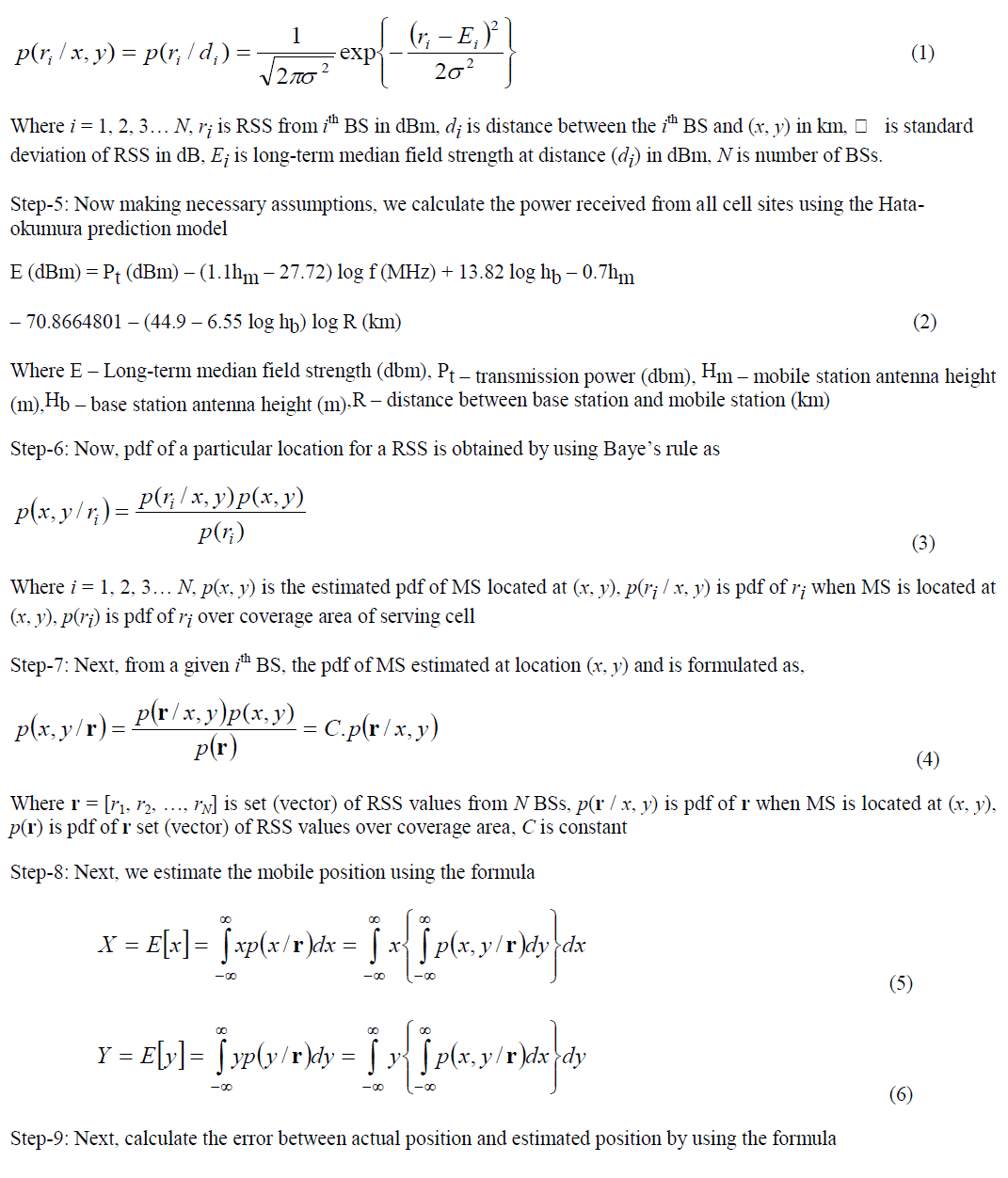 |
 |
| B. Estimated Results |
| Simulation results are obtained to evaluate the performance of RSS probability algorithm for typical GSM cell structure. The position fixing estimation results are obtained for various cell sizes. Vehicle traversed path (simulated) is estimated in the serving cell. All simulated results provided were average of several independent runs. |
| C. Comparison of Simulated Results for Various Cell Sizes |
| For the same GSM cell structure, by incrementing the cell size in steps of 0.5km each time, position estimation results are investigated. The estimated position fixing results, corresponding Root Mean Square (rms) error and multiplication factor (C' ) are presented.Simulation results indicate that estimated positions are well agreeing with actual location of MS. RMS error is calculated for each run and plotted in Fig.1and can be concluded that error increases as size of the cell side increases. The maximum error is occurred at cell side hexagon is 5km (which is the maximum cell size considered in the simulated runs). In all the cases, MS is assumed to be in the main cell. If not also, we can shift MS location virtually into main cell by coordinate transform technique. After estimating the position, it can be shifted back by the same technique. It is concluded that the developed algorithm performs very well for picocells where cell size (a) is less than 500m, because minimum estimated error is 4.44m only. This method is not advisable to use in rural areas where cell size is greater than 5km. |
| For various cell side lengths, multiplication factor (C' ) is estimated and is decreasing with increase in side length. From the observed results, multiplication factor is modeled as ninth degree polynomial of cell side length (a) (Eq.8). Estimated and modeled multiplication factors are plotted in Fig.2. It is very clearly evident from Fig.2 that, estimated and modeled factors (C' ) are in well agreement. From the established relation between cell size and multiplication factor (Eq.8), multiplication factor (C' ) can be easily calculated for any given cell size. |
 |
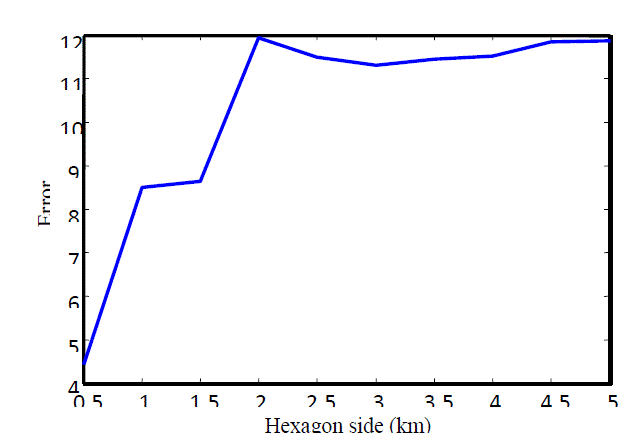 |
| Fig.1 Mean error versus cell side size |
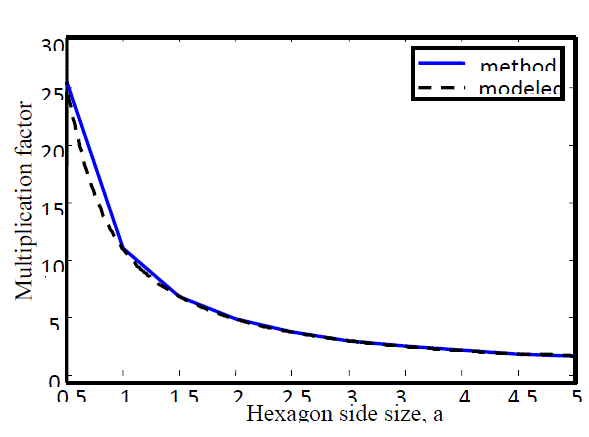 |
| Fig.2Variation of multiplying factor with hexagon side length |
| The actual and estimated paths are plotted in Fig.3. The figure shows how close the estimated path follows the true path. Initially (near to BS) the estimated path follows actual path very well. When moving away from the actual path. This can be attributed to the fact that as the MS moves away from BS, the dominance of probability of RSS from main cell becomes weak. Therefore, there exists a deviation between actual and estimated paths. |
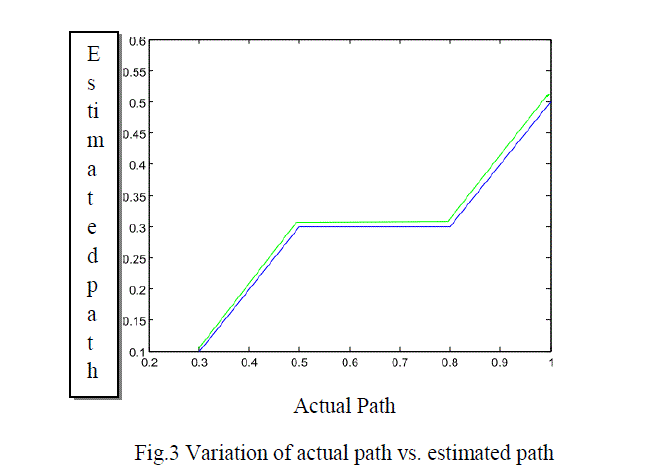 |
| D. Comparison of Simulated and Estimated Paths |
| A path is assumed (simulated) in a 3km, 4km, and 5km cell taking actual MS locations along a path with the regular intervals of about 0.2km. For assumed locations along the path, estimates are obtained using the probability algorithm. The errors can be attributed as a result of unmodeled multipath environment presented in the mobile channel. This method can take care of shadowing effect only. Therefore, this model requires further modifications to eliminate multipath instead of minimizing. The actual and estimated paths are plotted in Fig.4, Fig.5. The figure shows how close the estimated path follows the true path. Initially (near to BS) the estimated path follows actual path very well. When moving away from BS, the estimated path slightly moves away from the actual path. This can be attributed to the fact that as the MS moves away from BS, the dominance of probability of RSS from main cell becomes weak. Therefore, there exists a deviation between actual and estimated paths. Similar results are observed for other assumed paths in the main cell also. Vehicle path in other cells also can be estimated by coordinate transform technique. The cell containing the mobile vehicle automatically becomes main cell and surrounding cells become neighboring cells. Even if vehicle path passes through many cells, the same procedure can be adopted. |
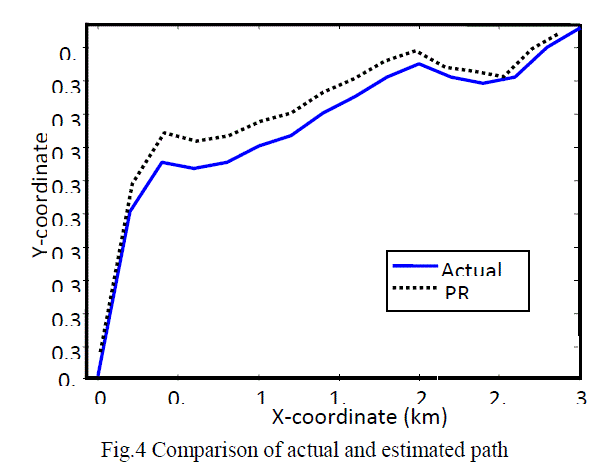 |
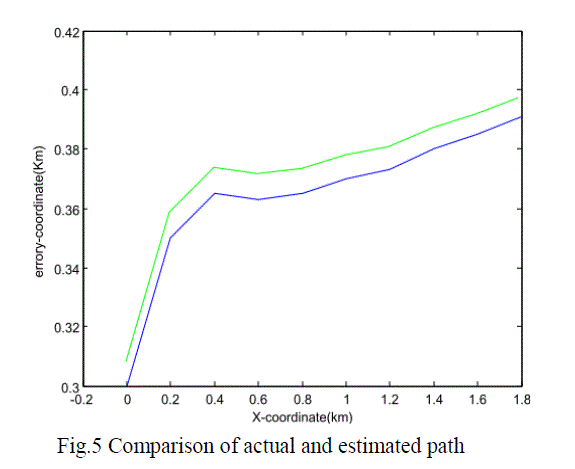 |
| E. Analysis of Position Estimate Errors for 3 km, 4 km, 5 km Cell Size |
| To effectively analyze the performance of a particular method, error analysis is necessary for both stationery and roaming cases. Position error is determined at various locations when MS moves away from main BS and towards the cell boundary. Variation of error with distance (between main BS and MS) is plotted in Fig.6, Fig.7. Table 1, can be observed that as MS moves away from the BS, the error increases. It can be easily attributed that the increase of error is due to decrease of dominant received signal strength. This is because of the domination of mobile environmental noises such as multipath. The minimum, maximum, mean and standard deviation of errors is presented in Table2. |
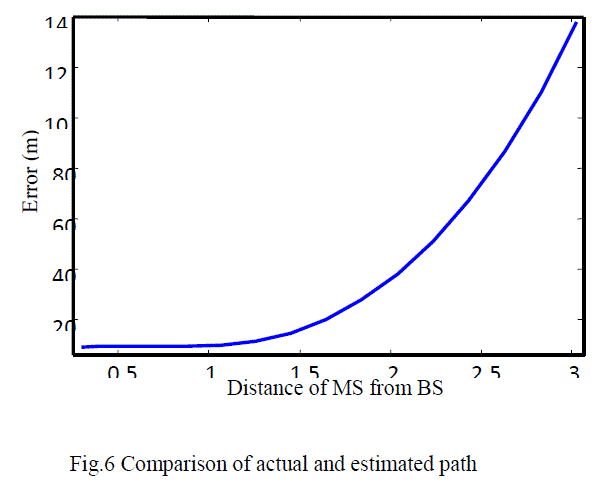 |
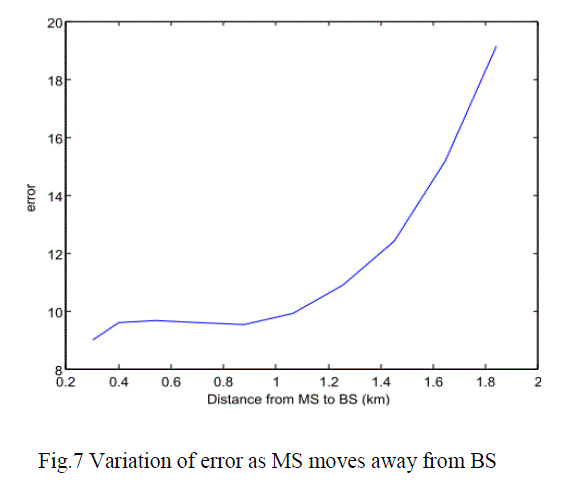 |
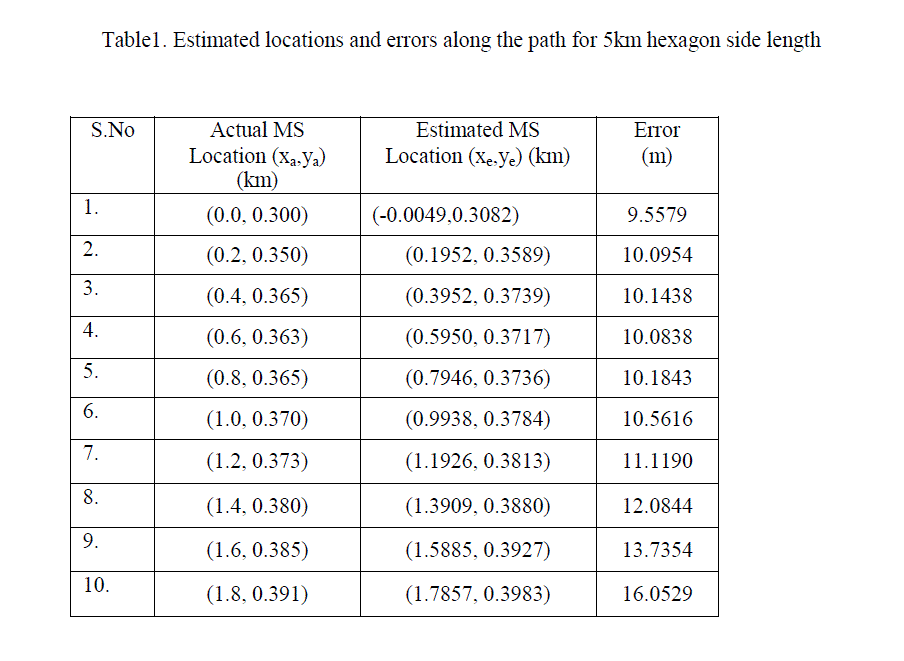 |
| E. Error Analysis of Position Estimates |
| Error performance parameters exist only for multiple estimates (stationary case). To evaluate the accuracy of estimations, performance measures such as minimum, maximum, mean square error (MSE) and standard deviation are determined and are presented in Table2. |
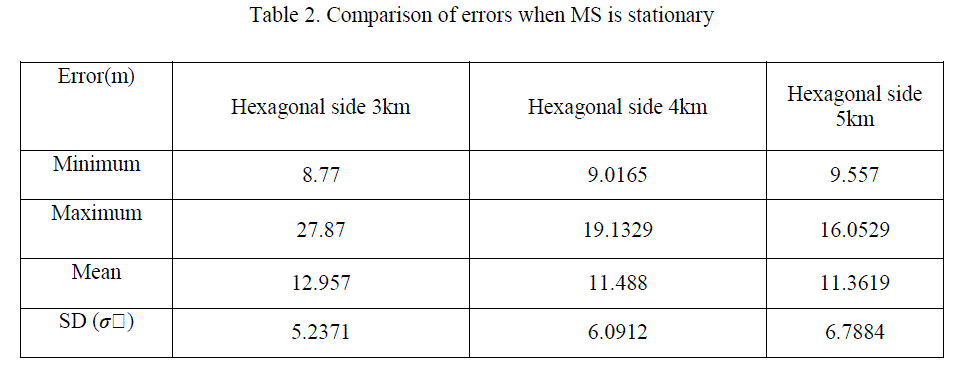 |
CONCLUSION |
| The main objective of this paper is to propose a method that can locate any GSM mobile hand phone with minimum implementation cost. This paper describes the importance of RSS measurements in position fixing. MS position estimation results obtained using probability of RSS method is more accurate than the conventional methods. Simulation results are encouraging with the mean positional error of 10.30 m. The estimated path is almost close to original path with a maximum error of 138 m when MS is near to the cell boundary. As MS moves away BS towards cell boundary position estimation error increases. From the simulated results we conclude that as the size of the cell increases error increases and also distance between MS and BS can be found easily. Experimental observed results are verified with GPS measurements and found reasonably matching. From the simulated results we conclude that as the size of the cell increases error increases and also distance between MS and BS can be found easily. This model requires further modifications to eliminate multipath instead of minimizing, to achieve better positional accuracy. It is advisable to use this method in Pico-cells (used in metropolitan areas) where more number of hearable BSs are assured. |
References |
|